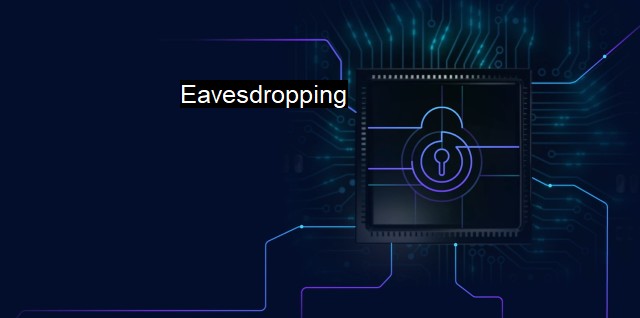What is Eavesdropping?
The Threat of Eavesdropping: Tackling Cyber Attacks on Communication Channels and Devices
Eavesdropping, in the context of cybersecurity and antivirus systems, refers to the unauthorised interception and monitoring of traffic data over a network. It parallels the act of stealthily overhearing a private conversation. The marked difference is that cyber eavesdropping attacks target networking activities rather than spoken words. It encompasses unauthorized capture of any data in transfer, such as user credentials, credit card details, confidential files, and more.To simplify, when a data packet travels from one point to the departing gateway, eavesdroppers capture this journey. While it may seem that cyber eavesdropping requires advanced technical skills and sophisticated equipment, the reality is that many casual hackers and cybercriminals exploit this security vulnerability using a variety of simple software tools openly available on the internet.
Eavesdropping is one of the oldest network attacks and poses severe ramifications to data privacy and confidentiality and is a prominent technique used in many other types of cybersecurity attacks. It can be executed in either a passive or active attack format. Passive eavesdropping generally involves simply listening to or capturing data packets to extract information, without alerting other network users about this illicit activity. Passive eavesdropping is harder to detect since there is no active manipulation or alteration of the data involved.
In contrast, active eavesdropping involves not only capturing data but also altering it. The attacker may create, modify, or delay the information in the communication stream. This method is a double-edged sword as it allows for active interference increasing the potential damage. active manipulation raises more red flags irrespective of how subtle the alterations may be, rendering detection likelihood higher.
An excellent example of an eavesdropping attack is ‘Man-in-the-Middle' (MitM), where an assailant places himself in the communication stream between two parties. The attacker captures the conversation or data exchange, changes its contents, and continues relaying the "message" without any party noticing the discrepancy.
The contiguity of eavesdropping becomes apparent within the realms of both cybersecurity measures and antivirus software approaches. It's a prevalent problem because digital communications often occur through an insecure network environment like the internet, making potentially sensitive information vulnerable.
In many scenarios, an antivirus system is not capable alone of securing data unless it works closely with comprehensive firewall settings and a thorough understanding of secure communication protocols. Beyond detecting and deleting viruses, antiviruses protect against spyware and other malicious software. failure to update an antivirus program can create a loophole for eavesdroppers to tap into, emphasizing the significance of always keeping one’s antivirus software up-to-date for optimal protection.
Counteracting eavesdropping thus requires the incorporation of security measures in every step-of-the-way of data communication, not limited to timely antivirus updating and maintaining robust firewalls. An SSL (Secured Socket Layer) can enforce a more guarded data transformation, encrypting information at the point of departure and decrypting it at the meant destination. An encrypted VPN, or a Virtual Private Network, creates a tunnel allowing data to navigate securely in transmission.
Eavesdropping presupposes a potent threat to cybersecurity and can lead to heavy losses if not appropriately addressed. It's essential to establish a solid, up-to-date security foundation and maintain vigilance as new threats continue to emerge. the call to prevent eavesdropping does not exclusively fall to the user. I.T industries must progress security systems in pace with the shifting landscape of cyber threats, building upon their antivirus measures and bolstering their counter-eavesdropping protocols.

Eavesdropping FAQs
What is eavesdropping in the context of cybersecurity and antivirus?
In the context of cybersecurity and antivirus, eavesdropping refers to the unauthorized interception of electronic communications, such as emails, phone calls or instant messages. This practice is often used by cybercriminals to steal sensitive information such as passwords, credit card numbers, or confidential business data.How can eavesdropping be prevented with antivirus software?
Antivirus software can help prevent eavesdropping by detecting and blocking malicious software that cybercriminals use to intercept electronic communications. To ensure maximum protection, it is essential to keep your antivirus software up to date, and to use strong encryption methods when sending sensitive information over the internet.What are some signs that my computer or mobile device may be eavesdropped on?
Some signs that your computer or mobile device may be eavesdropped on include unexpected pop-up windows, unusual network activity, slow internet connection speeds, unexplained crashes or freezes, and unfamiliar programs or files. If you suspect that your device may be eavesdropped on, you should run a thorough antivirus scan and consider contacting a cybersecurity expert for advice.What legal consequences can someone face for eavesdropping?
Eavesdropping is a serious crime that can result in significant legal consequences. Depending on the jurisdiction, the perpetrator may face fines, imprisonment, or both. In addition, victims of eavesdropping may be entitled to compensation for any damages suffered as a result of the crime. It is important to report any suspected cases of eavesdropping to the appropriate authorities to help prevent this type of criminal activity.Related Topics
Cybersecurity threats man-in-the-middle attacks firewalls Phishing attacks Mobile device security
| | A | | | B | | | C | | | D | | | E | | | F | | | G | | | H | | | I | | | J | | | K | | | L | | | M | |
| | N | | | O | | | P | | | Q | | | R | | | S | | | T | | | U | | | V | | | W | | | X | | | Y | | | Z | |
| | 1 | | | 2 | | | 3 | | | 4 | | | 7 | | | 8 | | |||||||